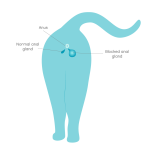The topic of anal glands might not be the most glamorous one, but trust us, it’s an important one – especially when it comes to your furry friend’s health and well-being. As a dog parent, you want to ensure that your loyal companion is happy, healthy, and free from any discomfort or pain.
Clean Your Dog’s Anal Glands: A Complete Guide
So, what are anal glands exactly? In simple terms, they’re two small sacs located on either side of a dog’s anus that produce a pungent, oily secretion to help mark their territory. While this natural behavior is normal and necessary for dogs to communicate with each other, it can sometimes cause issues if the glands become impacted or infected.
The Consequences of Neglecting Anal Glands
When anal glands become clogged or inflamed, it can lead to a range of unpleasant symptoms, including:
- Excessive scratching and licking at the affected area
- Redness, swelling, and discharge around the anus
- Foul odor emanating from the dog’s rear end
- Pain and discomfort during defecation or bowel movements
In this complete guide, we’ll delve into the world of anal glands and provide you with expert advice on how to clean your dog’s anal glands effectively. From understanding the anatomy to identifying potential problems and learning simple techniques for keeping those glands healthy, we’ve got you covered.
To properly clean your dog’s anal glands, it’s essential to understand their anatomy and how they function. Located on either side of the anus, these small sacs are connected to the rectum by a narrow duct. As mentioned earlier, the primary purpose of anal glands is to produce a pungent secretion that helps mark a dog’s territory.
Why Do Anal Glands Need Cleaning?
Despite their natural function, anal glands can become impacted or infected if not properly maintained. This is especially true for dogs with certain breeds or characteristics, such as:
- Bulldogs and other brachycephalic breeds
- Dogs with a history of gastrointestinal issues
- Pets that spend extended periods indoors
If left untreated, anal gland problems can lead to more serious health issues, such as skin infections or abscesses. Regular cleaning can help prevent these complications and keep your dog comfortable.
When Should You Clean Your Dog’s Anal Glands?
The ideal time to clean your dog’s anal glands depends on several factors, including their breed, age, diet, and health status. As a general rule of thumb:
- Newborn puppies typically don’t require cleaning until around 4-6 weeks old
- Puppies under 6 months should be cleaned every 2-3 weeks
- Dogs over 6 months can usually go 4-6 weeks between cleanings
However, if you notice any of the following symptoms, it’s best to consult with your veterinarian:
- Pain or discomfort during bowel movements
- Foul odor emanating from the dog’s rear end
- Redness, swelling, or discharge around the anus
How to Clean Your Dog’s Anal Glands?
Cleaning your dog’s anal glands is a simple process that requires some patience and the right tools. You’ll need:
- A warm compress or towel
- An anal gland cleaning solution (available at pet stores or online)
- Gently massaging fingers or an anal gland cleaning tool
To clean your dog’s anal glands:
- Start by applying the warm compress to the affected area for about 5 minutes. This will help soften any impacted debris.
- Use the anal gland cleaning solution to lubricate the area and make it easier to express the glands.
- Gently massage the area using your fingers or an anal gland cleaning tool. You may need to apply gentle pressure to encourage the glands to release their contents.
Remember to always prioritize your dog’s comfort and safety during this process. If you’re unsure or uncomfortable cleaning your dog’s anal glands, consult with your veterinarian for guidance. They can provide personalized advice and help you develop a maintenance routine that suits your pet’s unique needs.
In our next section, we’ll explore the importance of regular grooming and how it can help prevent anal gland issues in dogs. Stay tuned!
Get Expert Dog Care Advice
Don’t hesitate to ask our dog care experts for guidance on keeping your furry friend happy and healthy.
Get expert adviceIn our previous article, we explored the importance of cleaning your dog’s anal glands to prevent discomfort, pain, and even health issues. We discussed the consequences of neglecting this essential task, including excessive scratching, redness, swelling, foul odor, and pain during bowel movements.
Summarizing Our Key Points
To recap, we covered:
- The anatomy of anal glands and their purpose in marking territory
- The potential problems that can arise when anal glands become impacted or infected, such as excessive scratching, redness, swelling, foul odor, and pain during bowel movements
- A simple technique for cleaning your dog’s anal glands effectively, including gathering the necessary materials and following a step-by-step process
Final Insights
Remember that cleanliness is key when it comes to your dog’s anal glands. Regular grooming sessions can help prevent impaction and infection, reducing the risk of unpleasant symptoms and health issues.
A Strong Conclusion
In conclusion, cleaning your dog’s anal glands may not be the most glamorous task, but it’s a crucial part of their overall health and well-being. By following our simple guide and staying proactive about your dog’s anal gland care, you can help ensure they remain happy, healthy, and free from discomfort or pain.
So, go ahead and give those glands the attention they deserve – your furry friend will thank you!
Related Articles:
- Red bumps on head of penis: Are you experiencing unexplained bumps on the head of your penis? This article reveals the possible causes and treatments for this unusual phenomenon. Click to learn more about how to alleviate the discomfort and restore your confidence.
- What is clobetasol propionate cream equivalent: Are you searching for a substitute for clobetasol propionate cream? This article provides an in-depth comparison of similar creams and ointments, helping you make an informed decision about which one to use. Discover the alternatives that can provide comparable benefits.
- The estimating problem on page 734 and then answer the questions on page 735: Are you struggling with an estimation issue? This article presents a solution to the problem outlined in pages 734 and 735. Learn how to overcome this challenge and improve your calculation skills.



